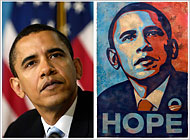 From the NY Times, Monday February 9th, 2009: In a pre-emptive strike, the street artist Shepard Fairey filed a lawsuit on Monday against The Associated Press, asking a federal judge to declare that he is protected from copyright infringement claims in his use of a news photograph as the basis for a now ubiquitous campaign poster image of President Obama.
From the NY Times, Monday February 9th, 2009: In a pre-emptive strike, the street artist Shepard Fairey filed a lawsuit on Monday against The Associated Press, asking a federal judge to declare that he is protected from copyright infringement claims in his use of a news photograph as the basis for a now ubiquitous campaign poster image of President Obama.
The great designer Milton Glaser (he created the iconic I ♥ NY logo and the famous Bob Dylan poster) is “discomforted” by Shepard Fairey’s use of an AP photo of Barack Obama as the reference for his now famous Hope poster.
From an interview in PRINT online:
Print: Fairey has referred to what he does as “referencing.” There’s certainly plenty of precedent for making reference to older artwork in new ones. How does one distinguish between plagiarism and reference?
Glaser: “The process of looking back at the past is very accepted in our business—the difference is when you take something without adding anything to the conversation. We celebrate influence in the arts, we think it’s important and essential. But imitation we have some ambivalence about, especially because it involves property rights. It probably has something to do with the nature of capitalism. We know that in other cultures, Chinese culture for instance, imitation is seen as a tribute, because you wouldn’t bother imitating trivial works. But in those cases the influence is acknowledged and the skill required is obvious.
“For myself—this is subjective—I find the relationship between Fairey’s work and his sources discomforting. Nothing substantial has been added. In my own case, when I did the Dylan poster, I acknowledged using Duchamp’s profile as an influence. I think unless you’re modifying it and making it your own, you’re on very tenuous ground. It’s a dangerous example for students, if they see that appropriating people’s work is the path to success. Simply reproducing the work of others robs you of your imagination and form-making abilities. You’re not developing the muscularity you need to invent your own ideas.”
Milton Glaser on Shepard Fairey and Plagiarism
* Earshot Presents has robbed itself of its imagination and form-making abilities by simply reproducing here the work of The New York Times, Boing Boing, Print Magazine, and Milton Glaser.
